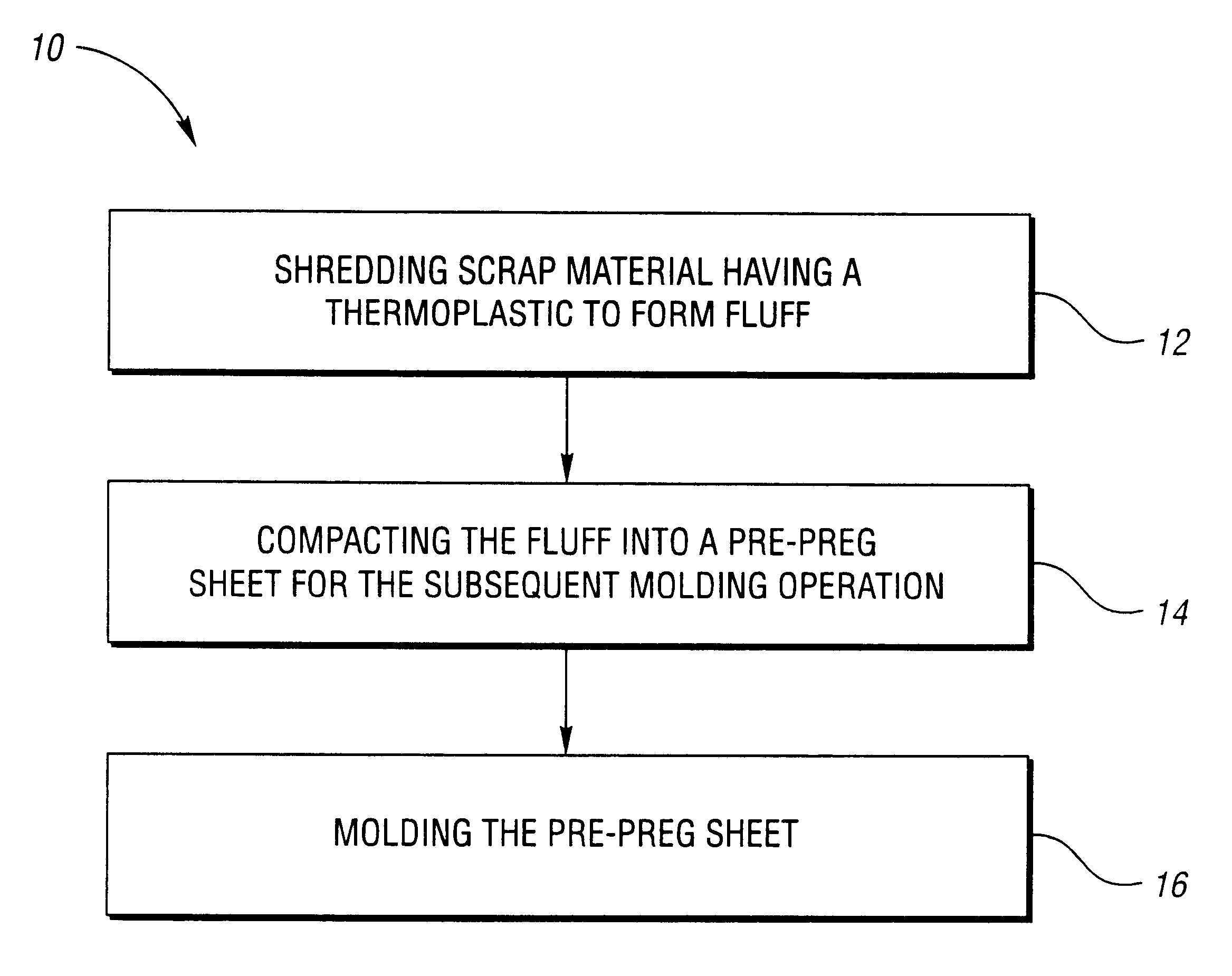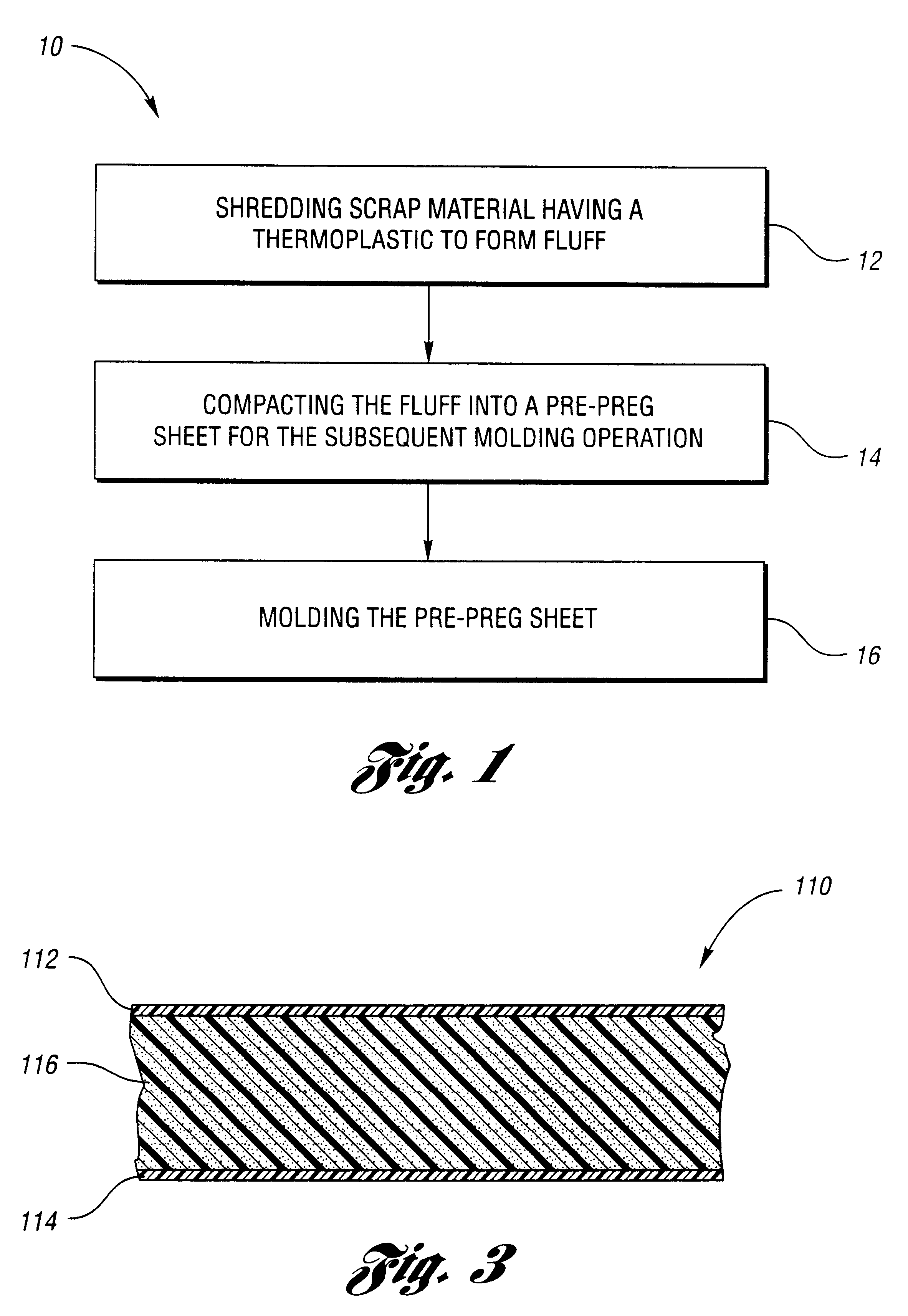Method of recycling scrap material containing a thermoplastic
a scrap material and thermoplastic technology, applied in papermaking, other domestic articles, chemical processes, etc., can solve the problems of large volume of post-consumer scrap material containing thermoplastics generated, scrap material that is difficult to recycle, and scrap material considered unrecyclabl
- Summary
- Abstract
- Description
- Claims
- Application Information
AI Technical Summary
Benefits of technology
Problems solved by technology
Method used
Image
Examples
example 2
In another example of an interior trim panel produced by the method of the present invention, PVC door offal scrap and automotive headliner scrap were collected and separately shredded to a particle size less than 4 mm, creating a PVC door offal fluff and an automotive headliner fluff. 50 percent by weight of PVC door offal fluff were vigorously mixed with 50 percent by weight of automotive headliner fluff using a Zig-Zag mixer, creating a mixture of fluff. The mixture was then moved and placed in a 2 feet by 2 feet compacting mold with a platen press and compacted into a pre-preg sheet at 232.degree. C. and 100 psi. The pre-preg sheet was then subjected to a thermoforming process for 10 seconds at 205.degree. C. and 280 psi. The molded product exhibited physical properties of 0.83 grams / cubic centimeter density, 1.5 MPa tensile strength, 10.4% elongation, and 73 MPa Young's modulus.
example 3
In another example of an interior trim panel produced by the method of the present invention, nylon carpet offal scrap and woodmat offal scrap were collected and separately shredded to a particle size less than 4 mm, creating a nylon carpet offal fluff and a woodmat offal fluff. 50 percent by weight of nylon carpet offal fluff were vigorously mixed with 50 percent by weight of woodmat offal fluff using a Zig-Zag mixer, creating a mixture of fluff. The mixture was then moved and placed in a 2 feet by 2 feet compacting mold with a platen press and compacted into a pre-preg sheet at 232.degree. C. and 100 psi. The pre-preg sheet was then subjected to a thermoforming process for 45 seconds at 205.degree. C. and 695 psi. The molded product exhibited physical properties of 1.10 grams / cubic centimeter density, 4.4 MPa tensile strength, 2.3% elongation, and 600 MPa Young's modulus.
example 4
In another example of an interior trim panel produced by the method of the present invention, nylon carpet offal scrap and automotive seat foam scrap were collected and separately shredded to a particle size less than 4 mm, creating a nylon carpet offal fluff and an automotive seat foam scrap fluff. 50 percent by weight of nylon carpet offal fluff were vigorously mixed with 50 percent by weight of automotive seat foam scrap fluff using a Zig-Zag mixer, creating a mixture of fluff. The mixture was then moved and placed in a 2 feet by 2 feet compacting mold with a platen press and compacted into a pre-preg sheet at 232.degree. C. and 100 psi. The pre-preg sheet was then subjected to a thermoforming process for 10 seconds at 205.degree. C. and 280 psi. The molded product exhibited physical properties of 1.10 grams / cubic centimeter density, 3.1 MPa tensile strength, 12.3% elongation, and 85 MPa Young's modulus.
PUM
| Property | Measurement | Unit |
|---|---|---|
| pressures | aaaaa | aaaaa |
| pressures | aaaaa | aaaaa |
| temperatures | aaaaa | aaaaa |
Abstract
Description
Claims
Application Information
 Login to View More
Login to View More - R&D
- Intellectual Property
- Life Sciences
- Materials
- Tech Scout
- Unparalleled Data Quality
- Higher Quality Content
- 60% Fewer Hallucinations
Browse by: Latest US Patents, China's latest patents, Technical Efficacy Thesaurus, Application Domain, Technology Topic, Popular Technical Reports.
© 2025 PatSnap. All rights reserved.Legal|Privacy policy|Modern Slavery Act Transparency Statement|Sitemap|About US| Contact US: help@patsnap.com



